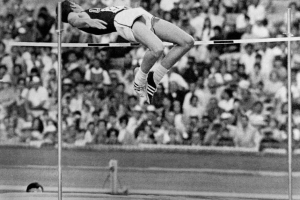
Athletics legend Dick Fosbury, who revolutionized high jumping with his signature “Fosbury Flop,” has died at the age of 76, his agent confirmed on Monday.
Fosbury’s agent Ray Schulte said in a statement that the 1968 Olympics gold medalist died peacefully in his sleep early Sunday from lymphoma.
“Dick will be greatly missed by friends and fans from around the world. A true legend, and friend of all!”
Born in Portland, Oregon, in 1947, Fosbury was to become one of the most influential athletes in the history of track and field for developing the innovative high-jumping technique which upended his sport in the 1960s.
Prior to Fosbury’s emergence, high jumpers typically attempted to clear the bar using the “straddle technique” in which they would take off face forward while attempting to twist their body mid-leap over the bar.
Fosbury, however, turned the conventional wisdom on its head with his new approach which would become immortalized as the “Fosbury Flop” and remains today the standard technique used by elite high jumpers.
Instead of tackling the bar head on, the rangy, 1.93-meter Fosbury would arc towards the bar on his run-up before taking off backwards and “flopping” over the bar.
“Few athletes in history have done their thing as uniquely as Dick Fosbury,” former United States high jump coach John Tansley wrote in 1980.
“He literally turned his event upside down.”
Fosbury first began experimenting with new ways of high jumping while still in school, hitting upon his new technique in 1963 during a competition in which he jumped a personal best of 1.65 meters using an old technique.
“Then they raised the bar and I knew I had to try something different to get over it,” Fosbury told Athletics Weekly in 2011.
“I knew I had to lift my hips up and to do that I needed to get my shoulders back out of the way. And I cleared the bar at the next height, eventually jumping 1.77 meters, so I improved by 15 centimeters that day.”
It was not until 1968, however, that Fosbury’s new approach gained global attention.
Victory at the U.S. college championships was followed by a win at the U.S. Olympic trials in Los Angeles.
At the Mexico City Olympics, Fosbury won the gold medal after clearing a height of 2.24 meters with his third jump – a new Olympic and U.S. record – to pip teammate Ed Caruthers, with the then Soviet Union’s Valentin Gavrilov taking bronze.
Fosbury’s performances at the Olympics electrified the stadium, with Mexican fans delighted by the American college student’s bold approach.
“No track and field athlete at the Olympic Games drew more whoops of delight or shrieks of disbelief from the crowds… than did Dick Fosbury, the architect of an acrobatic maneuver that has become known as the ‘Fosbury Flop’,” the New York Times commented at the time.
Fosbury would say later that he never saw himself as a revolutionary and did not anticipate that his style would become the standard technique for high jumping.
“I have had the blessing and good fortune to have made a contribution to the sport, but I did not set out to do this,” he told Athletics Weekly.
“I was not trying to change the event. I knew that my technique was my path to success. And I had this technique which was mine – mine alone.”
Fosbury was the only competitor using the “Fosbury Flop” in the 1968 Olympics. By the time of the 1972 Munich Games, 28 of 40 competitors in the discipline had adopted his style.
“I thought that after I won the gold, one or two jumpers would start using it, but I never really contemplated that it would become the universal technique,” Fosbury said in 2012.
“Yet, it only took a generation.”
